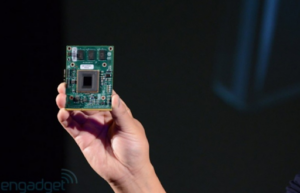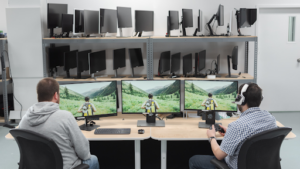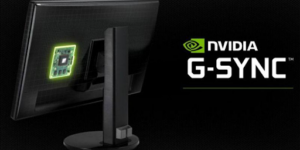What Is G-SYNC And What Does It Do?

You’ll definitely come across several displays touting Nvidia’s G-Sync technology while looking for a gaming monitor. In addition to a significant price increase, these monitors typically have gaming-specific features such a quick reaction speed and faster refresh rate. We created a tutorial to address this question: What Is G-Sync And What Does It Do? to assist you in understanding where your money is going.
G-Sync, to put it briefly, is a hardware-based adjustable refreshing technology that aids in the reduction of screen rippling and instability. At even faster refresh rates, a G-Sync display will provide you with a smoother gaming experience.
What exactly is G-Sync?

Nvidia’s hardware-based panel synchronizing technique is called G-Sync. G-Sync mostly eliminates screen rippling by matching the refresh rate of your display to the number of frames your GPU produces every second.
Each second, your GPU outputs a number of frames, which when combined provide the appearance of seamless motion. Similar to how your monitor refreshes, your GPU renders new frames while clearing the old ones for your GPU to display. Future frames are buffered by your GPU to maintain smooth operation. The issue is that your monitor’s refresh rate and buffer might go out of sync, leading to an ugly line of two consecutive frames sewn together.
This software-based function effectively compels your GPU to store frames through its buffers until your display is prepared to refresh. Screen ripping is no longer an issue; however, input latency is now present. Due to V-Sync, there is a little lag between what is happening within the game and what’s displayed on the screen. This is because V-Sync compels your GPU to store frames that it has previously rendered.

Adaptive VSync was the first V-Sync replacement offered by Nvidia. In order to avoid screen tearing, Nvidia’s driver-based approach limited the fps to the display’s refresh rate. However, Adaptive VSync released the frame rate while the GPU was having trouble until its performance improved. When the frame rate was steady, Adaptive VSync locked it until the GPU’s functionality fell once more.
In 2013, Nvidia unveiled G-Sync, a hardware-based solution. It is based on the Adaptive-Sync technology from VESA, which allows for varying refresh rates on the panel interface. G-Sync causes your display to adjust its refresh rate in accordance with the number of frames that your GPU is rendering rather than requiring your GPU to retain frames. That addresses screen tearing and input latency.
Nvidia, on the other hand, employs a custom board in place of the traditional scalar board that manages every aspect of the display, including backlight management and picture input decoding. The 768MB of DDR3 ram on a G-Sync board is used to save the earlier frame so that it may be matched to the incoming frame. This is done to lessen input latency.
On the PC side, the Nvidia driver has complete control over the board used for the display. The period between when the monitor completes rendering the present frame and the start of the following frame is known as the vertical blanking interval or VBI, and it tries to manipulate this time.
The display becomes your PC’s slave when G-Sync is turned on. The display cleans up the old image and prepares to accept the new frame while the GPU moves the generated frame further into the primary buffer. Your PC instructs the display to render each frame as the fps increase and decrease. The G-Sync board’s flexibility for varied refresh rates means that visuals are often regenerated at wildly changing intervals.
System requirements for G-Sync

In order to know What Is G-SYNC And What Does It Do? it requires; With G-Sync displays, there has always been one significant restriction: An Nvidia graphics card is necessary. The term “G-Sync Compatible” is used to describe more modern G-Sync displays that enable HDMI variable refresh rate, even if an Nvidia GPU, such as the recently released RTX 3080, is still required to fully utilize G-Sync. This implies that while Nvidia’s complete G-Sync module is not compatible with an AMD card, the variable refresh rate is. Here is everything you require in addition to a monitor with a G-Sync banner: –
- Desktop computers:-
- GeForce GTX 650 (Ti BOOST) or a later model
- R340.52 or above for drivers
- Laptops coupled with G-Sync displays
- Nvidia Gtx 980M, GTX 970M, as well as GTX 965M GPU or later is required
- R340.52 or above for drivers
- Laptops having G-Sync screens built-in
- Nvidia Gtx 980M, GTX 970M, as well as GTX 965M or later is the recommended GPU
- R352.06 or above for drivers
G-Sync against G-Sync Compatible versus G-Sync Ultimate

There are three varieties of G-Sync. The least expensive option is G-Sync Compatible because it does not necessitate display makers to incorporate or buy Nvidia’s technology, whereas G-Sync Ultimate is geared for consumers who want to watch HDR content. Industry-wide, G-Sync is the norm. Many G-Sync Compatible and FreeSync Certified monitors are available.
| G-Sync | G-Sync Ultimate | G-Sync Compatible |
| Validated for artifact-free performance | Validated for artifact-free performance | Validated for artifact-free performance |
| Certified with over 300 tests | Certified with over 300 tests | |
| Certified for 1,000 nits brightness with HDR |
The G-Sync Ultimate
In contrast to normal G-Sync, Nvidia approves G-Sync Ultimate screens for super duper low latency, multi-zone backlights, DCI-P3 color gamut coverage, 1,000 nits maximum brightness with HDR video or games, and to operate at its highest framerate at its max resolution — all made possible by “advanced” Nvidia G-Sync processors. Remember that these monitors tend to be BFGDs (large-format gaming displays), which makes them more expensive.
The G-Sync Compatible
In 2019, Nvidia started analyzing and approving certain displays, including those that ran G-Sync using FreeSync or even other Adaptive-Sync technology. These monitors are G-Sync Compatible. Although G-Sync Compatible displays don’t have the same processors as a G-Sync / G-Sync Ultimate panel, our testing has proven that they can still support G-Sync when using the proper driver and adhering to a few limitations.
According to Nvidia, some G-Sync-related behaviors are forbidden. In contrast to standard G-Sync displays, extremely low motion blur, overclock, and configurable overdrive is compatible displays.
Some drawbacks

One negative aspect is the expense. Regardless of whether you’re considering a desktop computer or a laptop, G-Sync requires a powerful display and graphics card. Regardless of the fact that there is a heck of a lot of G-Sync compatible graphics chips available and a tonne of cost-effective alternatives, G-Sync displays are almost always more expensive than its AMD Freesync equivalents. Compatibility-enhanced PCs may cost even more.
Conclusions
Here we can conclude that your answer to What Is G-SYNC And What Does It Do? Has been given. Now the decision is up to you.